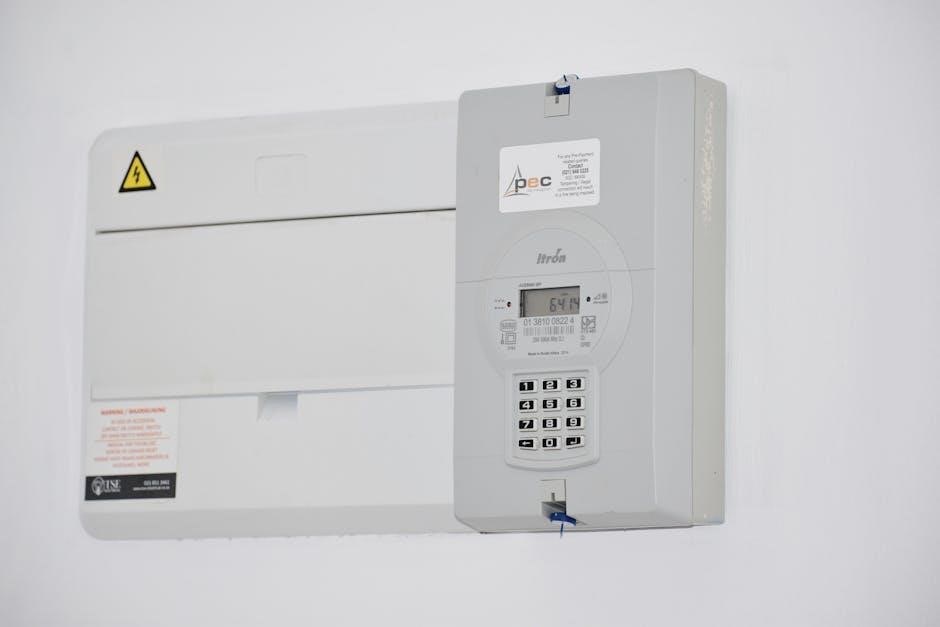Welcome to the comprehensive guide for the 2003 Ford Taurus fuse box. This guide provides detailed diagrams, locations, and functions of fuses and relays to help you troubleshoot and repair electrical issues. Learn how to identify blown fuses, replace them safely, and understand the layout of both the passenger compartment and engine fuse boxes; Essential for DIY enthusiasts and mechanics, this guide ensures you can maintain and repair your vehicle efficiently.
With step-by-step instructions and clear diagrams, this resource covers common fuses, such as the cigar lighter (Fuse 13) and stop lamp (Fuse 17), as well as relays like the Powertrain Control Module (PCM). Whether you’re addressing a faulty accessory or diagnosing a complex electrical problem, this guide is your go-to reference for the 2003 Ford Taurus.
Understanding the Fuse Box Layout
The 2003 Ford Taurus features a well-organized fuse box layout, with two main compartments: the passenger and engine areas. Each compartment is divided into sections with varying fuse ratings, ensuring proper electrical distribution and overload protection. This design simplifies diagnostics and maintenance by segregating interior and exterior systems, allowing for efficient troubleshooting and repairs. The layout includes relays for high-current circuits, enhancing overall electrical management and reliability. Understanding this structure is essential for identifying and addressing electrical issues effectively.
2.1. Passenger Compartment Fuse Panel
The passenger compartment fuse panel is located behind the glove box and contains essential fuses for interior systems. It houses fuses like Fuse 13 (cigar lighter) and Fuse 17 (stop lamp), each serving specific functions. This panel is crucial for managing electrical components such as lighting, accessories, and safety features. Its organized layout allows for easy access and maintenance, ensuring efficient troubleshooting and repairs for the vehicle’s interior electrical systems.
2.2. Power Distribution Box Diagram
The power distribution box diagram illustrates the layout and connections within the engine compartment fuse box. It details high-current fuses and relays, such as the Powertrain Control Module (PCM) Relay and ABS/Traction Control Relays. This diagram helps identify each component’s role, ensuring proper diagnostics and repairs. By understanding this scheme, you can efficiently trace electrical circuits and address issues related to the vehicle’s power distribution system.
Fuse Box Locations
The 2003 Ford Taurus features two main fuse boxes: one in the passenger compartment and another in the engine compartment. These locations are essential for accessing and diagnosing electrical components efficiently.
3.1. Passenger Compartment Fuse Box
The passenger compartment fuse box is located on the driver’s side of the instrument panel. It houses essential fuses and relays for various electrical systems, including the cigar lighter (Fuse 13) and the Powertrain Control Module (PCM) relay. This fuse box is part of the instrument panel and contains a fuse junction panel, ensuring reliable power distribution to key vehicle components. Regular inspection is recommended to maintain electrical system performance.
3.2. Engine Compartment Fuse Box
The engine compartment fuse box is located on the driver’s side of the engine bay, near the battery. It contains high-current fuses and relays for systems like the powertrain control module (PCM) and ABS. This box is crucial for protecting electrical circuits related to the engine and traction control. Regular checks are essential to ensure optimal performance and prevent potential electrical failures that could disrupt engine operation or safety systems. Always refer to the fuse diagram for accurate identification.

Fuse Box Diagrams
This section provides detailed diagrams for both the passenger compartment and engine fuse boxes, helping you quickly locate and identify fuses and relays for easy troubleshooting and repair.
4.1. Passenger Compartment Fuse Box Diagram
The passenger compartment fuse box diagram illustrates the layout and functions of fuses in the dashboard panel. Located on the driver’s side, it includes key fuses like Fuse 13 (cigar lighter) and Fuse 17 (stop lamp). The diagram shows the arrangement of fuses and relays, such as the ABS and traction control relays, with clear labels for easy identification. Use this diagram to locate and diagnose issues quickly, ensuring proper electrical system maintenance for your 2003 Ford Taurus.
4.2. Engine Compartment Fuse Box Diagram
The engine compartment fuse box diagram details the layout of fuses and relays in the power distribution box, located under the hood. This diagram highlights fuses for essential systems like the powertrain control module (PCM) and ABS. It also includes relays for traction control and other vital functions. Use this diagram to identify and troubleshoot issues related to engine performance and electrical components efficiently, ensuring your 2003 Ford Taurus runs smoothly.

Common Fuses and Their Functions
This section outlines essential fuses in the 2003 Ford Taurus, such as the cigar lighter fuse (Fuse 13) and stop lamp fuse (Fuse 17), crucial for electrical systems and safety features. Understanding their roles helps in diagnosing and resolving common electrical issues efficiently.
5.1. Cigar Lighter Fuse (Fuse 13)
Fuse 13 is the cigar lighter fuse, located in the Instrument Panel fuse box for the 2003 Ford Taurus. It powers the vehicle’s cigarette lighter and accessory power outlets. If this fuse blows, the lighter and related accessories will stop functioning. Replacing it with a 10-20 amp fuse restores functionality. Always ensure the correct amp rating is used to avoid electrical damage or fire hazards.
5.2. Stop Lamp Fuse (Fuse 17)
Fuse 17 controls the stop lamp circuit in the 2003 Ford Taurus. Located in the passenger compartment fuse panel, it ensures proper operation of the brake lights. If this fuse blows, the brake lights will not illuminate, potentially causing safety issues. Inspect and replace Fuse 17 with a 10-amp fuse if necessary. Always test the brake lights after replacement to confirm functionality and ensure compliance with traffic safety regulations.
Relays in the Fuse Box
Relays in the 2003 Ford Taurus fuse box control various electrical systems. They amplify power to components like the fuel pump and ABS. Faulty relays can cause system malfunctions and require replacement.
6.1. Powertrain Control Module (PCM) Relay
The Powertrain Control Module (PCM) relay is crucial for managing engine functions. Located in the passenger compartment fuse box, it regulates power supply to the PCM, ensuring smooth engine operation. If faulty, it can cause issues like rough idling or stalling. Testing and replacing this relay requires care to avoid damaging the PCM or other electrical components.
6.2. ABS and Traction Control Relays
The ABS (Anti-lock Braking System) and Traction Control relays are essential for safety systems. Located in the fuse box, they ensure proper functionality of brakes and stability control. If these relays fail, warning lights may illuminate, and systems could malfunction. Always consult a professional for diagnosis and replacement to maintain safety and performance. Proper relay function is critical for reliable vehicle operation.

Tools and Materials Needed
Essential tools include a fuse puller, multimeter, and replacement fuses. Safety gear like gloves and goggles is also recommended. Ensure you have the correct fuse ratings and types for your vehicle. A wrench or screwdriver may be needed to access the fuse boxes. Always refer to your owner’s manual for specific requirements. Proper tools ensure safe and effective fuse replacement and troubleshooting.
7.1. Essential Tools for Fuse Replacement
To replace fuses in your 2003 Ford Taurus, you’ll need a fuse puller, which is often found in the fuse box compartment. A multimeter can help test for power and continuity. Additional tools include a screwdriver or wrench for accessing the fuse boxes and replacement fuses of the correct amperage rating. Keep a pair of gloves and goggles on hand for safety. Ensure all tools are compatible with your vehicle’s specifications to avoid damage or injury.
7.2. Safety Equipment
When working with your 2003 Ford Taurus fuse box, wear protective gloves and safety goggles to prevent injury from potential electrical sparks. Keep a fire extinguisher nearby in case of emergencies. Ensure the vehicle is on level ground and in park with the ignition off. Always disconnect the battery before starting work to avoid electrical shocks or short circuits;
Use a fuse puller to avoid touching live electrical components. Never bypass fuses or use incorrect replacements, as this can cause electrical fires or damage to your vehicle’s systems. Proper safety equipment ensures a safe and successful fuse replacement process.

Safety Precautions
Always disconnect the battery before working on the fuse box to prevent electrical shocks. Wear protective gloves and ensure the vehicle is in park with the ignition off.
Avoid touching electrical components to prevent damage or injury. Never bypass fuses, as this can cause electrical fires or system damage; Follow proper procedures to ensure safety.
8.1. Disconnecting the Battery
Disconnecting the battery is an essential safety step before working on the fuse box. Locate the battery in the engine compartment and loosen the negative (-) terminal using a wrench. Completely remove the negative cable first, then the positive (+) cable. This prevents electrical shocks or short circuits. Insulate the negative terminal to avoid accidental contact. Always reconnect the positive cable first and tighten both terminals securely after completing repairs.
8.2. Handling Electrical Components
When handling electrical components, always wear insulated gloves and use tools with insulated handles to prevent electric shock. Avoid touching electrical terminals or components with bare hands, as skin oils can cause corrosion. Ensure the area is dry to prevent short circuits. Ground yourself by touching a metal surface to discharge static electricity; Never force connections or bend wires, as this can damage the system. Always follow proper procedures to avoid electrical hazards.
Step-by-Step Guide to Locating Fuses
Consult the fuse box diagrams to identify locations. Access the appropriate fuse box (passenger or engine compartment). Use the diagram to pinpoint the specific fuse position.
9.1. Identifying Fuse Locations
To identify fuse locations in your 2003 Ford Taurus, refer to the fuse box diagrams provided in your owner’s manual or online resources. The passenger compartment fuse panel is located behind the glove box, while the power distribution box is found in the engine compartment on the driver’s side. Each fuse box diagram labels fuses by number and function, such as Fuse 13 for the cigar lighter or Fuse 17 for the stop lamps. Cross-referencing these diagrams ensures accurate identification.
To check the condition of fuses in your 2003 Ford Taurus, start by locating the fuse boxes. The passenger compartment fuse panel is behind the glove box, and the power distribution box is in the engine compartment. Remove the fuse using a fuse puller and inspect for signs of damage, such as broken elements or discoloration. Use a multimeter to test for continuity, ensuring the fuse is not blown. Replace any damaged or blown fuses with the correct amperage rating. Always disconnect the battery before working on electrical components to ensure safety. Regular inspections help prevent electrical system malfunctions and ensure reliable vehicle operation.
Interpreting Fuse Box Diagrams
9.2. Checking Fuse Conditions
Locate the fuse boxes: passenger compartment behind the glove box and power distribution in the engine compartment. Use a fuse puller to remove and inspect for damage or discoloration. Test with a multimeter for continuity to identify blown fuses. Replace damaged ones with the correct amperage rating. Always disconnect the battery before working on electrical components for safety. Regular inspections prevent malfunctions and ensure reliable operation.
10.1. Understanding Fuse Box Legend
The fuse box legend explains the symbols and abbreviations used in the diagrams. It helps identify fuse locations, ratings, and functions. Common symbols include circles for fuses and lines for connections. Abbreviations like “PCM” (Powertrain Control Module) indicate specific systems. Referencing the legend ensures accurate identification of components like Fuse 13 (cigar lighter) or Fuse 17 (stop lamp). This section is crucial for interpreting diagrams and troubleshooting electrical systems effectively in your 2003 Ford Taurus.
10.2. Reading Fuse Box Schemes
Reading fuse box schemes involves interpreting the visual layout to identify fuse locations and their corresponding systems. Use the legend to decode symbols and abbreviations. Trace circuits to understand how components are connected. This step helps diagnose issues like blown fuses or faulty relays. By following the scheme, you can pinpoint the correct fuse for systems like the cigar lighter (Fuse 13) or stop lamps (Fuse 17), ensuring accurate repairs for your 2003 Ford Taurus.
Troubleshooting Common Fuse Issues
Troubleshooting fuse issues involves identifying blown fuses and understanding their impact on vehicle systems. Common problems include faulty accessories or electrical malfunctions. Check fuses like Fuse 13 (cigar lighter) or Fuse 17 (stop lamp) for failures. Use the fuse box diagram to trace circuits and diagnose issues efficiently. Replace blown fuses with the correct amperage rating to restore functionality and prevent further damage to your 2003 Ford Taurus.
11.1. Identifying Blown Fuses
Identifying blown fuses in the 2003 Ford Taurus requires checking the fuse box diagrams and visually inspecting the fuses. Use the fuse panel diagram to locate the correct fuse. Remove the suspect fuse and examine it for a broken element or darkened glass. Common blown fuses include Fuse 13 (cigar lighter) and Fuse 17 (stop lamp). Always test with a voltmeter to confirm power loss before replacing a fuse.
11.2. Common Electrical Problems
Common electrical issues in the 2003 Ford Taurus include blown fuses for the stop lamp (Fuse 17) and cigar lighter (Fuse 13). Faulty relays, such as the ABS and traction control relays, can also cause system malfunctions. Additionally, wear and tear on the fuse box connectors may lead to intermittent power loss. Regular inspection of the fuse box and relays helps prevent these issues and ensures reliable vehicle operation.
Replacing Fuses
Disconnect the battery, identify the blown fuse, and remove it using a fuse puller. Install a replacement fuse of the same amperage rating and reconnect the battery to test the electrical system.
12.1. Steps to Replace a Fuse
- Disconnect the battery to ensure safety while working with electrical components.
- Locate the blown fuse using the fuse box diagram for identification.
- Remove the fuse using a fuse puller or appropriate tool.
- Inspect the fuse for visible damage or wear;
- Install a replacement fuse with the same amperage rating.
- Reconnect the battery and test the affected system to confirm repair.
Always refer to your owner’s manual for specific instructions and precautions.
12.2. Testing After Replacement
After replacing the fuse, reconnect the battery and test the system to ensure proper function. Turn on the affected electrical component, such as the radio or lights, to confirm it works. Check for any error lights or unusual behavior. If the issue persists, inspect the fuse box for additional blown fuses. Consult your owner’s manual for specific testing procedures for your vehicle’s systems.
13.2. Preventing Fuse-Related Issues
Maintenance and Tips
Regularly inspect the fuse box for signs of wear or damage. Clean corrosion from fuse contacts and replace worn-out fuses promptly to prevent electrical issues. Always use the correct fuse rating to avoid damage. Keep a spare set of fuses in your vehicle for emergencies. Proper maintenance ensures reliable performance and prevents unexpected system failures.
